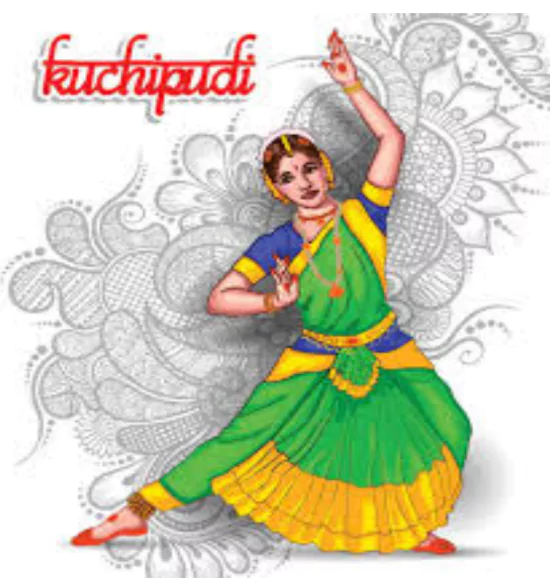Introduction
Kuchipudi, from Andhra Pradesh, is a classical dance form renowned for its blend of grace, intricate footwork, and dramatic storytelling. It originated in the village of Kuchipudi and often incorporates elements of both dance and theater.
Origin and Evolution of Kuchipudi

- The dance form derives its name from the Andhra village of Kusselavapuram.
- It was originally performed by a group of actors going from village to village, known as Kusselavas.
- It symbolises the element of earth.
- It remained confined to villages till the nineteenth century, when Balasaraswati and Ragini Devi revived this dance form.
- In the 17th century, Siddhendra Yogi, a Vaishnava poet, introduced the Kuchipudi style of Yakshagana and composed Bhaamaakalaapam.
- He trained young Brahmin boys from Kuchipudi village to perform his compositions.
- In 1675 AD, Abdul Hasan Tanishah (Nawab of Golconda) granted the village of Kuchipudi as an Agrahaarama to Brahmin families who pursued this art.
- By the mid-20th century, it emerged as a distinct solo classical dance style.
- Thus, there are now two forms of Kuchipudi: the traditional musical dance-drama and the solo dance.
- Solo dance includes Manduka Shabdam (story of a frog), Jala Chitra Nrityam (the dancer draws pictures on the floor with his or her toes while dancing) etc.
Enroll now for UPSC Online Course
Structure of a Kuchipudi Solo Recital
- The recitals are based on stories of Bhagwata Purana but have a secular theme.
- There is a predominance of Shringaara ras.
- The performance has Sollakath or Patakshara (Nritta part, where body movement is made) and Kavutvams (Nritya part involving extensive acrobatics).
- Performance structure: The dance begins by invoking Gods, followed by nritta, involving non-narrative and abstract dancing, often featuring the jatiswaram.
- Next is shabdam, a narrative performance with favourites like “Dashaavataara.”
- A Natya number succeeds the narrative section like the entry of Satyabhama from “Bhaamaakalaapam.”
- The recital then transitions to a pure nritya-abhinaya, involving literary and musical forms like padam, jaavli, and shlokam.
- The performance usually concludes with Tarangam, where excerpts from Krishna-leela-tarangini are sung.
- Standing on a brass plate, the dancer locks the feet in shakata-vadanam paada and balancing a pitcher of water on the head, displays acrobatic skills.
- Music: Kuchipudi dance is accompanied by classical Carnatic music.
- A mridangam player for percussion, a violin or veena player, and a cymbal player conducts the orchestra and recites the “sollukattus” (rhythm syllables).
- Famous Proponents: Radha Reddy and Raja Reddy, Yamini Krishnamurthy, Indrani Rehman etc.
Enroll now for UPSC Online Classes
Conclusion
- Kuchipudi, rooted in Andhra Pradesh’s cultural tapestry, showcases a seamless fusion of tradition and innovation.
- Its vibrant performances, characterized by dynamic movements and expressive narratives, continue to enchant audiences worldwide, perpetuating the rich legacy of Indian classical dance.
![]() April 12, 2024
April 12, 2024
![]() 2720
2720
![]() 0
0
